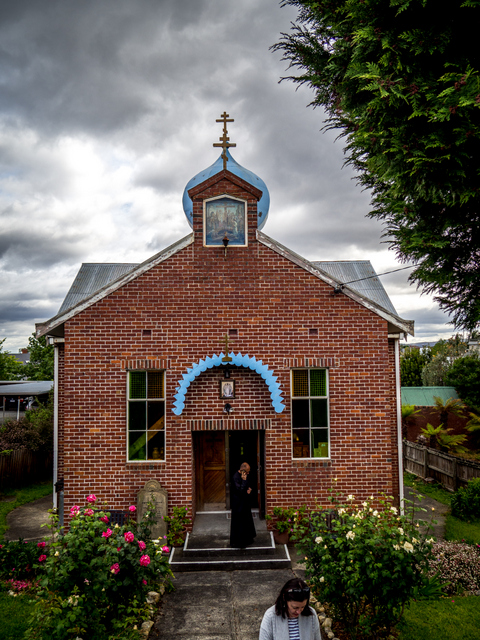Another Open House Hobart has provided amazing access to many ‘secret’ places most of us would otherwise never be able to see. This initiative of the Australian Institute of Architects invites people to be a tourist in their own city and opens some of Tasmania’s most beautiful and interesting buildings to the public, including private homes and historic buildings.
Earlier this year, the program extended to Launceston, with the city’s first Open House weekend.
My first stop on Saturday morning was not far from home.

The Exhaultation of the Holy Cross Russian Orthodox Church is just around the corner from my home but I’d never been inside, until Saturday morning. Founded by the late Mitred Archpriest Theodore Boriskevich in 1949, this temple serves a mixed Russian, Serbian & Australian Orthodox community.
The architectural legacy of Esmond Dorney has been a feature of Open House Hobart from the beginning. Originally from Melbourne, Dorney was a leader in bringing modernist design to Hobart’s suburbs in the post-way years. His own former home on the slopes of Mount Nelson is now in public ownership and has been a fixture on the program, and each year it seems another, privately owned example of his oevre is made accessible. This year, a house overlooking Lenah Valley was included in the program.
After a quick stop at another, tinier, modenist apartment in Lenah Valley which was too crowded for taking photographs, I thought it was time to revisit some of Tasmania’s colonial heritage. I hadn’t been inside the Penitentiary Chapel for many years, and was happy to see that some quality interpretation has been installed to help tell the story of this place.
Dating back to the convict era, the Penitentiary Chapel was Hobart’s, and Tasmania’s principle place of incarceration through until the 1960s, when the Risdon Gaol was opened.
It also housed Tasmania’s Supreme Court, and was also where capital sentences were carried out, the last execution taking place in 1946.
I have vague recollections of attending parties in flats tucked into various eeries of Hobart’s skyline during my youth, so I was delighted to see that a couple of such flats, albeit no longer occupied, were open for viewing.
The first, and most impressive, was the spacioius Caretakers Apartment atop Hobart’s City Hall. While I don’t recall any parties here, I do have some vague memory of having visited at some point. But the views, and the spacious rooms, were pretty impressive.
The City Hall itself was also open, and accessible from a stairway leading down from the roof. It is a classic ‘shoebox’ style hall and would be great for music, if it weren’t surrounded by several of the city’s major roads.
I do have memories of covering election nights here during my ABC days and of attending various performances, and even having a role in arranging a Tasmanian Symphony Orchestra performance of Beethoven’s Ninth Symphony here to mark the Orchestra’s 50th anniversary. That was back in the days before it moved across the road to the Federation Concert Hall, a move in which I also had a hand.
I always enjoyed the view from a stage, if not the appearing in front of hundreds of people. So this audience suited me well.
The Caretakers’ Flat attached to the Carnegie Building (now home to the Tasmanian Maritime Museum, but formerly Hobart’s first public library) was less impressive and spacious, but with views across Davey Street to the docks. It would have been pretty inconvenient, with the small accommodation rooms on the top floor and the bathroom and toilet about five narrow, twisting flights of stairs below in the basement.
Glance to the side as you drive to or from Hobart up the highway near Mona and you’ll notice this curious structure in the forecourt of a motel. The Coronation Arch was constructed to welcome Queen Elizabeth’s 1954 visit to Tasmania and was originally placed across the entrance to Liverpool Street in the centre of Hobart. It subsequently moved to Glenorchy before being bought by the Motel Derwent (now the Riverfront Motel) in 1960.
The design of the Riverfront Motel itself calls to mind the movies, fashions and lifestyle of the Hollywood Rat Pack in Palm Springs, and it’s undergoing a sensitive refurbishment to highlight many of its original features. The hotel seems to have newfound hipster credibility due to its design heritage and to its close proximity to the Museum of Old and New Art.
The Motel incorporates a 1960s bungalow called The River House that embodies mid-century design chic, and which is now available as accommodation for those wanting to live the lifestyle for a while.
Having enjoyed these weekends as a guest for several years, I felt compelled to help out this time, so on Sunday I volunteered my time to help. I was the greeter for visitors to the Lady Gowrie Centre in South Hobart, where they were given a tour by lead architect and partner at Cumulus Studios, Peter Walker. I didn’t manage to grab any photos of my own, but check out #oh_hobart on Instagram and you’ll be bound to see a few – it’s certainly worth a look, and look out for it if it is open again next year.
One Comment
Comments are closed.